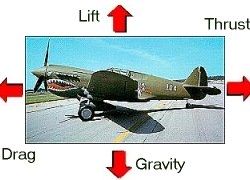|
Flight Model in Simulation Design: A Forum
by David Zurawski |
||||
|
Wayward Design Q1&2 Q1) Firstly, we have modeled the world. This includes simple things such as the height of the ground and gravity, but also complex things such as the physical properties of water, bumpy grass, icy tarmac etc. Also in the world we model the atmosphere, with pressure, density and temperature all varying with altitude. Then weather, clouds, wind, gusts, turbulence etc. Next we break the vehicles in our world, (that includes the ground vehicles as well as the aircraft) down into their component parts, which we model separately. Weight distribution and payloads, wheels, brakes, suspension, airfoils and their modifiers (e.g. flaps), engines, propellers etc are all modeled individually. To implement an aircraft, we create a wrapper and place all the relevant parts into it, at the correct physical locations. Some of the components, most notably the propellers and airfoils cause secondary effects in the world: turbulence, vortices etc which not only effect the other components of that aircraft, but other aircraft nearby as well. Q2) For us, the advantages of the component approach are simple. Each component is self-contained, easy to maintain and can be tested in isolation. Any aircraft can be modeled quickly and easily by assembling the correct parts with the correct specifications. We can have a new plane in the world within an hour and expect it to handle very realistically from the start. Only mild tweaking of the numbers is usually required to finalize the model. But we can just as easily create physical models for jeeps, trucks etc using the same components. Parsoft Q1&2 Q1) The OpenPlane engine models forces, which simulate the forces that a real aircraft is subjected to. Each aircraft is composed of many different parts which all have weight, create drag and some cause lift. We build our aircraft in much the same way that a real aircraft is built, by the aggregation of individual parts which all work together. We start by creating the fuselage and adding objects with mass and aerodynamic properties such as wings, fuel cells, gear, guns, etc. By the time we're done, we have an aircraft which very closely matches its real-world counterpart. Q2) Our greatest advantage is that our model is based at its core, on real-world physics. This is also our greatest bane; if an aircraft "looks" right, but isn't balanced correctly, it can be very difficult to fly. The result of the work required is a flight model that re-creates "flight" as no other simulation can. Response I must be missing something ... Based on these responses; great length is taken to micro-manage every aspect of the flight model. Seemingly every possible piece and nuance was being modeled. It's obvious that the fidelity of today's flight models are head and shoulders above older simulations like WarBirds (which incidentally seems to be the "measuring-stick" all simulations are held up to), yet they still seem to fall under microscopic scrutiny by players. If there is a problem out there, maybe it's not the "engines" themselves but the data applied to them. Having said that, I asked: |
 Q 3.) In user groups and forums, one of the greatest debates focuses on the "accuracy and authenticity" of today's flight simulations. Explain how you've collected information regarding flight performance data and how do you qualify it for authenticity? Q 4.) In hindsight, what is the most difficult thing in respect to modeling WWII aircraft? Looking Glass Q3&4 Q3) First, we gathered all the ORIGINAL pilot manuals and performance charts for each and every aircraft modeled in our game, a difficult and exhausting task (so much so that some of our German plane manuals had to be translated from German to English). Bob Shaw (yep, THE Bob Shaw), helped us out immensely with this. Second, we built what we call the "Flight Model Editor" - a Wind tunnel tool that allows us to plug in values directly from performance tables and tweak those values in real time as we are running the simulation. This really helps us fine-tune and hone the physics and flight modeling, as we can bring in pilots, have them fly a particular model, comment on it and instantly tweak characteristics. Third, to apply the gathered plane specifications to our flight model, we basically have to "work backwards" from the specs to come up with appropriate values for the parameters in our model. For all its advantages, the force-based approach does present one significant challenge. It is often very difficult to translate high-level performance characteristics into force values. For example, if the spec says a plane has an optimal climb rate of 2000fpm, there's no simple formula for figuring out what the corresponding parameter values in our model should be. In fact many parameters affect the optimal climb rate, as an example: air pressure. Also if you manage to set the parameters such that the model does indeed have that optimal climb rate, its very likely that the accuracy of the model with respect to some other performance parameter, like max roll rate, has been compromised. Q4) For the most part, we don't have access to the pilots or the planes of WWII so we can only go by the high-level performance data that is generally available, such as top speed, rate of climb, takeoff distance, etc. We said we have a force-based model, and there is basically no force data available for WWII planes. Even to model a plane of today, the manufacturer might be hard-pressed to find such data and even if they had it, might not be authorized to give it to us. Go to Part III
|
|||
|
Copyright © 1997 - 2000 COMBATSIM.COM, INC. All Rights Reserved. Last Updated October 4th, 1999 |
||||
